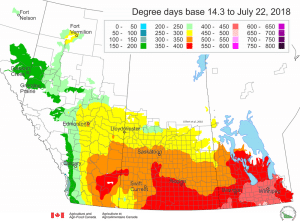The Prairie Pest Monitoring Network also tracks Culex tarsalis, the mosquito that carries West Nile virus. Read the last PPMN update on this topic, including notes from Health Canada on West Nile virus. The map below shows the regions most advanced in degree-day accumulations for Culex tarsalis. Areas highlighted yellow then orange are approaching sufficient heat accumulation for mosquitoes to emerge. Culex tarsalis is already flying in areas in red. Wear DEET to stay protected!
Map of the Week – West Nile


